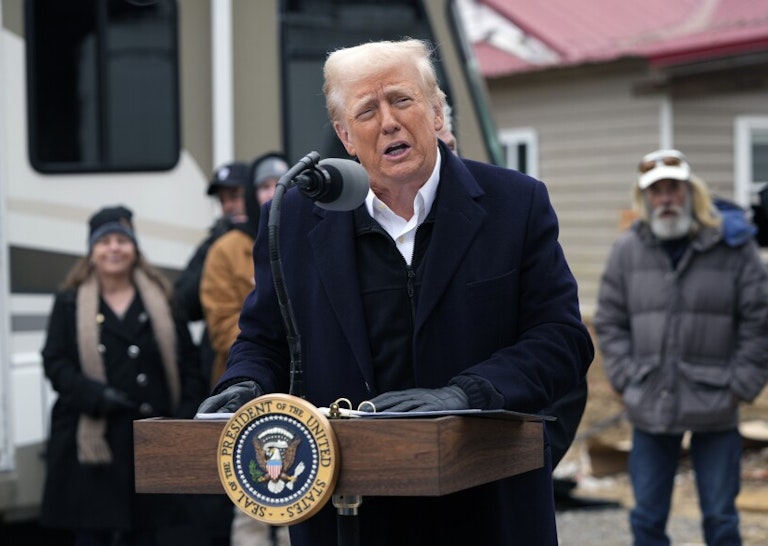Ronald Reagan Institute
Trump Has a Point About Eliminating FEMA

By Dr. Tevi Troy

President Trump caused a stir on Friday with a suggestion to eliminate the Federal Emergency Management Agency and transfer its responsibilities to the states. Liberals such as Rep. Brad Sherman (D., Calif.) rushed to defend FEMA. But for states to serve as the primary responders to disaster is consistent with our Constitution and much of our history.
The Constitution doesn’t mention disaster response or emergency management. The idea that the federal government could handle disaster management wouldn’t have occurred to anyone in the 18th and early 19th centuries, before modern communications and transportation allowed for rapid cross-country awareness and response. Even as these technologies advanced, presidents of both parties saw disaster response as primarily a state and local responsibility.
When the 1889 Johnstown, Pa., flood killed more than 2,200 people, a group of local leaders sent a telegram to President Benjamin Harrison asking for help. Harrison responded that “what you need is systematic work under proper authority. If the governor and your State Board of Health make any call upon me in any matter in my discretion, I will gladly respond.” In other words, this was the state’s responsibility, not the federal government’s.
Harrison’s response—for which the people of Johnstown thanked him—was representative of bipartisan 19th-century attitudes about federal and state responsibilities. Harrison’s Democratic predecessor (and successor) Grover Cleveland two years earlier vetoed funding to help Texas farmers recover from a drought, writing, “I can find no warrant for such an appropriation in the Constitution.”
Expectations changed in the 20th century as the federal government and national media expanded. Comedian Will Rogers mocked President Calvin Coolidge for a sluggish response to the 1927 Great Mississippi Flood, gibing that Coolidge was taking it slow in the “hope that those needing relief will perhaps have conveniently died in the meantime.” The joke worked because there was general awareness of the situation and a feeling that more should be done.
The federal government grew dramatically during the New Deal era—from 593,000 employees in 1932 to 2.2 million in 1946—and so did expectations for government involvement in disasters. Television inflated these expectations even more. Images of citizens suffering aroused sympathy across the country.
In 1965 President Lyndon B. Johnson visited New Orleans in the aftermath of Hurricane Betsy at the urging of Sen. Russell Long, touching down a mere five hours after Long called him. Johnson pledged to cut “red tape” and got more involved in hurricane response than was typical for a president. President Richard Nixon followed suit, stepping in with federal aid following 1969’s Hurricane Camille. He sent 16,500 military personnel to the area, as well as Vice President Spiro Agnew.
With a series of executive actions in 1978 and 1979, President Jimmy Carter formalized the federal government’s disaster response. He created FEMA and gave it responsibility for disaster management and civil defense. These actions combined federal functions previously performed by multiple agencies, including the departments of Commerce, Defense, Housing and Urban Development and the General Services Agency. This consolidation increased public expectations regarding the federal role in disaster response.
The sense that George H.W. Bush was inattentive to domestic concerns grew due to the perceived slowness of Bush’s response to 1992’s Hurricane Andrew. The signature moment of that disaster came when Kate Hale, director of emergency operations for Dade County, Fla., asked at a televised news conference, “Where in the hell is the cavalry on this one?” With Bush hurt by the Andrew failure, he lost the 1992 presidential election to Bill Clinton. Presidents since have been aware that their handling of local disasters can affect their national reputations.
George W. Bush, while attentive to weather disasters in his first term, stumbled through 2005’s Hurricane Katrina in his second. While there was no shortage of failures on the federal side, the major problems stemmed from the incompetence of the local response. It should also be noted that another Bush, Jeb, took his father’s challenges to heart and established a reputation as an effective emergency manager while governor of Florida.
While disaster response has become a political football at the federal level, it isn’t clear that federal involvement makes disaster response better. Federal involvement can add inefficiencies; central planning always does. The federal government must maintain full-time staff in preparation for any kind of disaster nationwide, while states can be more nimble and hire staff more tailored for the disasters most likely to occur in their region. FEMA also adds an additional layer of bureaucracy to what is already a complex management situation. And the agency can add an unwelcome political dimension to disaster response, as we saw when one FEMA official told workers not to stop at homes with Trump signs following Hurricane Milton.
Despite these potential benefits, Mr. Trump should tread carefully. The federal government became increasingly involved in disaster relief because of the increased expectations of the American people. Moving crisis management to the states can be a good idea, but it needs to be sold aggressively to the American people in order to revise public expectations for how we handle disasters.
Join Our Newsletter
Never miss an update.
Get the latest news, events, publications, and more from the Reagan Institute delivered right to your inbox.
